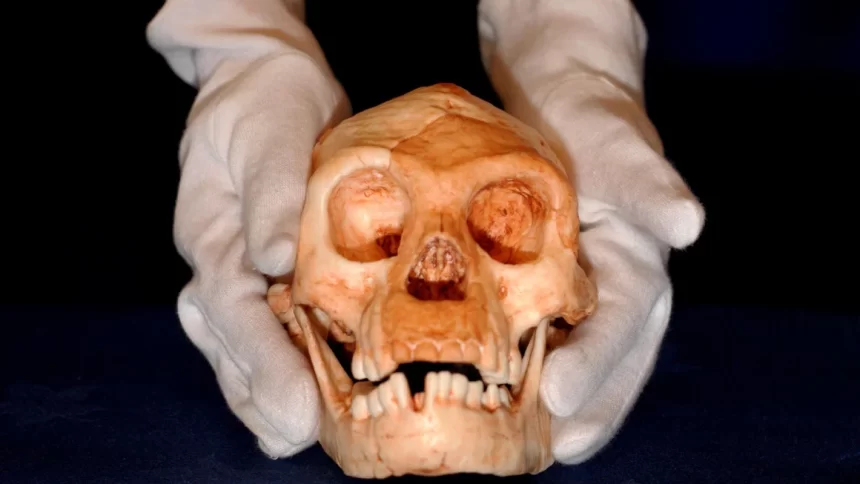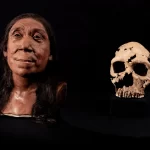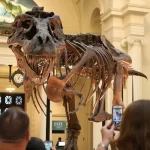Indonesian archaeologist Thomas Sutikna was nursing a fever in a hotel room on September 2, 2003, when a coworker shared news of what turned out to be a once-in-a-generation discovery.
Earlier that day, a colleague’s trowel had hit a tiny human-like skull encased in 6-meter (19.7-foot) deep sediment in Liang Bua, a large cave in the highlands of the Indonesian island of Flores that Sutikna and his colleagues had been excavating since 2001. Sutikna’s fever immediately vanished, and after a fitful night’s sleep, he and his team set off for the site at sunrise.
They were thrilled to uncover more bones — some still attached to one another — in the same location at the high-ceilinged cave.
“There were leg bones, hand bones, tibia, femur, grouped in there, in one context.
Given the very fragile condition of the bone, it was not possible to lift it (out of the ground) immediately,” recalled Sutikna, now an archaeologist and researcher at Indonesia’s Center for Archaeometric Research at the country’s National Research and Innovation Agency.
To harden the brittle exposed bone, he applied some acetone nail polish remover bought from a cosmetics store mixed with glue the team had on site.
The team then brought the blocks of cut sediment containing the bones back to the hotel by minibus.
Wahyu Saptomo, one of the field archaeologists who had first told Sutikna about the discovery, remembered that they placed the blocks of soil on their laps — the safest place during a bumpy minibus ride on an unpaved road.
At first, the team thought perhaps the tiny skull and other bones belonged to a child, but as Sutikna cleaned the fossil at the hotel, he saw it had the molar teeth of an adult. It appeared to be a completely new kind of human, a female specimen with a perplexing combination of features that stood just over 3 feet (about 1 meter tall) and would have weighed around 66 pounds (30 kilograms).
“We were all surprised by the fossil, because after cleaning it could be seen that the teeth had all grown and were intact. The skull bones also showed that it was an adult bone, not a child’s skull,” said Sutikna, who subsequently took the fossil to Jakarta, the Indonesian capital.
Now, 20 years later, scientists are still struggling to definitively place this enigmatic piece of the evolutionary puzzle. But the journey sparked by its discovery has led to revelations that challenge what’s known about the human family tree.
Explosive discovery
The team and its international collaborators knew from the start that what they had found was groundbreaking, and they worked hard to keep their discovery secret for more than a year so the remains could be studied in detail.
When they released the results of their research, in two studies published in the high-profile scientific journal Nature just over a year later, the findings shook up the field of paleoanthropology and captivated a wider audience, making headlines around the world.
Nicknamed hobbit — the massively popular first “Lord of the Rings” film had come out in late 2001 — by Mike Morwood, the late Australian archaeologist who had spearheaded the dig, the Liang Bua specimen looked like something from the movie’s Middle Earth realm.
The volume of its braincase, measured with mustard seeds smuggled from Australia through Indonesian customs, was around 400 milliliters, similar to a chimpanzee. (The volume of a modern human braincase is 1,500 milliliters.) Its legs were short, with disproportionately large feet, and its arms long like a primate.
Initial dating of carbon in the sediment determined the remains to be 18,000 years old, which was startlingly young, putting the previously unknown species closer in time to us than the Neanderthals. (The dates were revised in 2016, estimating instead that the hobbit was 50,000 to 60,000 years old.)
The Liang Bua team named the species Homo floresiensis after the island where the fossils were discovered. (Two other names were considered: Homo hobbitus — passed over because it was thought to trivialize the find — and floresianus — rejected after the realization that it meant flowery anus.)
The discovery challenged the idea that humans evolved in a neat line from primitive to complex and underscored just how much remained unknown about the human story.
“(The specimen) was just wrong in about five different ways and unexpected to the point of people thinking like this can’t be possible,” said Paige Madison, a historian of paleoanthropology and science writer who is working on a book about the hobbit titled “Strange Creatures Beyond Count” to be published in 2025
How the hobbit came to be
Some experts in human evolution vehemently argued the Liang Bua bones were those of a modern human with a growth disorder — such as microcephaly, a condition that leads to an abnormally small head, a small body and some cognitive impairment. That assertion unleashed a fierce debate that took years to resolve.
The team that discovered the hobbit disagreed and put forward two theories. Most likely, members of the team thought, their find was a dwarfed offshoot of Homo erectus — the first human species to leave Africa and migrate around the world, the remains of which have been discovered in Java and elsewhere in Asia.
The shape of the teeth and skull morphology were similar, though Homo erectus stood much taller. It was possible, the researchers thought, that Homo erectus had done what some other species of animals that live on remote islands have — shrunk over time in response to limited resources.
However, the tiny brain case and chimplike wristbones suggested the hobbit was related to australopithecines — small-bodied hominins, best known from the famous Lucy fossil, that roamed Africa more than 2 million years ago. This potential link raised the possibility that australopithecines also once migrated out of Africa millions of years ago.
Exactly how the hobbit came to be is still an open question, said Chris Stringer, research leader in human evolution at the Natural History Museum in London.
“I’m on the fence on this one because I can see the evidence for both sides of the argument,” Stringer said, “and I think we really still don’t know where its origins are.”
However, the idea that the hobbit was a diseased modern human has been largely rejected, he said.
The subsequent discovery of two other small-bodied and small-brained hominins that lived relatively recently — Homo naledi in South Africa and Homo luzonensis in the Philippines — and the much larger Denisovans has led to a wider acceptance among paleoanthropologists that there have been many, diverse species of human, including several that coexisted with our own species, Homo sapiens. Before the discovery of the hobbit, many experts in human evolution thought essentially only one species of human had evolved through time, with regional variation.
‘So many unknowns’
Matt Tocheri, Canada research chair in human origins at Lakehead University in Thunder Bay, Ontario, first saw casts of the Liang Bua hobbit around 2006 during a presentation on the fossils’ conservation at the Smithsonian Institution. An expert in wristbone evolution, he was immediately stunned to see that the wrists more closely resembled those of an African ape than a human, an observation that swayed him toward the idea that Homo floresiensis is more closely connected to Lucy and her relatives than a scaled-down Homo erectus.
In 2014, a partial Homo floresiensis jawbone and teeth were found on a different site on Flores called Mata Menge and dated to 700,000 years ago — considerably older than the original specimen. They were similar in size, if not smaller, than those found in Liang Bua, suggesting that the Flores hobbits had acquired their extremely small body size by that early point, working against the idea that the hobbits were evolutionary dwarfs of some kind.
However, other experts argue that dwarfism could have happened even deeper in the past or on a different island.
It’s also possible, Tocheri noted, that the hobbit’s small stature is a result of sexual dimorphism — when the two sexes have different physical characteristics. The working hypothesis is that the Liang Bua hobbit is female because of the broader shape of its pelvis, and it’s not clear what a male hobbit might have looked like. While more than 100 Homo floresiensis fossils — likely belonging to six or seven individuals — have been unearthed to date, there’s only one relatively complete skeleton and only one skull, which is the most informative body part.
Tocheri, who is now closely involved with archaeological work on Flores, keeps an open mind. “There are still so many unknowns; we have to be very careful,” he said.
To resolve these debates and understand more about Homo floresiensis and its place in the human family tree, more fossil discoveries are needed, particularly in Asia. For example, Tocheri noted, there are no known Homo erectus wristbones for him to compare with the hobbit’s.
Scientists also hope to be able extract ancient DNA from Liang Bua. Attempts so far have been unsuccessful, but new techniques — including extracting DNA from cave dirt or decoding ancient proteins — could help shed light on which hominin the hobbit is most closely related to.
“They see it as kind of like a holy grail of genomes,” said Madison, the science writer. “It seems that the hobbit is probably at the edge of possibility as far as recovering a genome. Not because it’s too old, because they have genomes much older, but because the environmental conditions are so important in preserving that (DNA). And those hot environments, humid environments, those are really difficult environments for them to retrieve DNA.”
Homo floresiensis: A ‘whole other chapter’
There’s still much to learn about the hobbit. Sutikna marvels at how such a primitive-looking hominin might have reached Flores: Only Homo sapiens were thought to be able to make oceangoing vessels, and Flores has never been connected to a large landmass, so ancient humans couldn’t have walked there.
The study of ocean currents suggests that the species might have come from Sulawesi, an island to the north, rather than the closer islands to the west, although Homo floresiensis fossils have still only been found on Flores. Stringer said he thinks it’s possible that a group of hobbits was swept on a raft of land in the aftermath of a tsunami.
Archaeologists and paleontologists have also pieced together some information about the hobbits’ lives. Their island was home to a now-lost ecosystem of dwarfed elephants called stegodons that stood 1.2 meters (3.9 feet) high, colossal 2-meter-tall (6.6-foot-tall) storks, Komodo dragons and giant rats.
It’s not clear whether the hobbits would have hunted or scavenged these animals, although Tocheri said it was most likely the latter given the hobbits’ size. While charcoal has been found in the cave, it’s now thought that this evidence of fire use is associated with the later occupancy of modern humans, rather than the hobbits.
Another mystery is why the hobbits disappeared after surviving for so long on Flores. Sutikna said that a thick layer of volcanic ash was found just on top of the layer where Homo floresiensis was first found.
“We estimate that at least eight volcanic eruptions have occurred. And above the volcanic ash layer, we did not find any fossils of Homo floresiensis or other ancient animals,” he said. “However, we cannot confirm whether this natural disaster destroyed Homo floresiensis.”
Tocheri said it’s unlikely that a volcano alone doomed the hobbits. The island of Flores had always been volcanically active, and the hobbit had lived there for the nearly 1 million years. More likely, it was a combination of factors. A changing climate, perhaps combined with the arrival of Homo sapiens in the region, could have played a role, Tocheri said.
Whatever led to its extinction, the hobbit’s discovery teaches us about humanity’s place in the evolutionary tree and nature more broadly, according to Madison.
“We know a lot about evolutionary principles at this point, but sometimes I think we’re a little bit hesitant to apply them to ourselves,” Madison said. “I think that (this discovery) reminds us that we’re just one evolutionary outcome.”
Tocheri agreed. “It didn’t really rewrite what we knew, but it just explosively showed us that there was this whole other chapter.”










